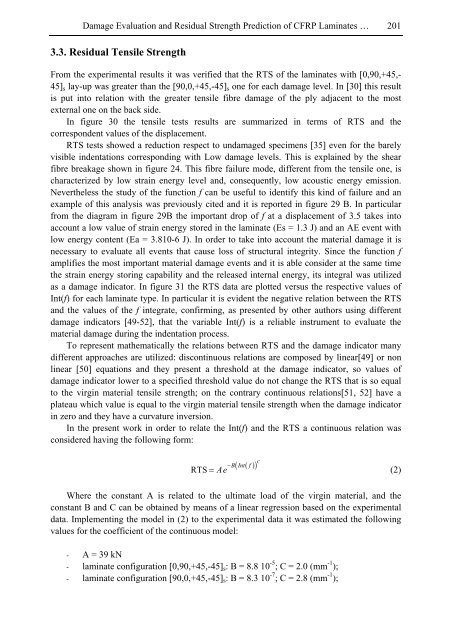Composite Materials Research Progress
Composite Materials Research Progress
Composite Materials Research Progress
You also want an ePaper? Increase the reach of your titles
YUMPU automatically turns print PDFs into web optimized ePapers that Google loves.
Damage Evaluation and Residual Strength Prediction of CFRP Laminates … 201<br />
3.3. Residual Tensile Strength<br />
From the experimental results it was verified that the RTS of the laminates with [0,90,+45,-<br />
45]s lay-up was greater than the [90,0,+45,-45]s one for each damage level. In [30] this result<br />
is put into relation with the greater tensile fibre damage of the ply adjacent to the most<br />
external one on the back side.<br />
In figure 30 the tensile tests results are summarized in terms of RTS and the<br />
correspondent values of the displacement.<br />
RTS tests showed a reduction respect to undamaged specimens [35] even for the barely<br />
visible indentations corresponding with Low damage levels. This is explained by the shear<br />
fibre breakage shown in figure 24. This fibre failure mode, different from the tensile one, is<br />
characterized by low strain energy level and, consequently, low acoustic energy emission.<br />
Nevertheless the study of the function f can be useful to identify this kind of failure and an<br />
example of this analysis was previously cited and it is reported in figure 29 B. In particular<br />
from the diagram in figure 29B the important drop of f at a displacement of 3.5 takes into<br />
account a low value of strain energy stored in the laminate (Es = 1.3 J) and an AE event with<br />
low energy content (Ea = 3.810-6 J). In order to take into account the material damage it is<br />
necessary to evaluate all events that cause loss of structural integrity. Since the function f<br />
amplifies the most important material damage events and it is able consider at the same time<br />
the strain energy storing capability and the released internal energy, its integral was utilized<br />
as a damage indicator. In figure 31 the RTS data are plotted versus the respective values of<br />
Int(f) for each laminate type. In particular it is evident the negative relation between the RTS<br />
and the values of the f integrate, confirming, as presented by other authors using different<br />
damage indicators [49-52], that the variable Int(f) is a reliable instrument to evaluate the<br />
material damage during the indentation process.<br />
To represent mathematically the relations between RTS and the damage indicator many<br />
different approaches are utilized: discontinuous relations are composed by linear[49] or non<br />
linear [50] equations and they present a threshold at the damage indicator, so values of<br />
damage indicator lower to a specified threshold value do not change the RTS that is so equal<br />
to the virgin material tensile strength; on the contrary continuous relations[51, 52] have a<br />
plateau which value is equal to the virgin material tensile strength when the damage indicator<br />
in zero and they have a curvature inversion.<br />
In the present work in order to relate the Int(f) and the RTS a continuous relation was<br />
considered having the following form:<br />
C<br />
BInt ( ( f)<br />
)<br />
RTS Ae −<br />
= (2)<br />
Where the constant A is related to the ultimate load of the virgin material, and the<br />
constant B and C can be obtained by means of a linear regression based on the experimental<br />
data. Implementing the model in (2) to the experimental data it was estimated the following<br />
values for the coefficient of the continuous model:<br />
- A = 39 kN<br />
- laminate configuration [0,90,+45,-45]s: B = 8.8 10 -5 ; C = 2.0 (mm -1 );<br />
- laminate configuration [90,0,+45,-45]s: B = 8.3 10 -7 ; C = 2.8 (mm -1 );
















